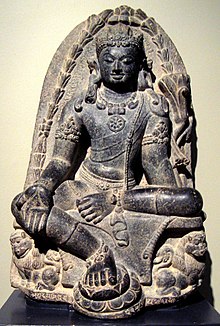Manĝuŝrio
Aspekto
| Mañjuśrī (Sanskrito) | |
 Manĝuŝrio, bodisatvo de saĝo | |
| Sanskrite: | मञ्जुश्री (Mañjuśrī) |
| Ĉine: | 文殊菩薩 (Wénshū-púsà) 文殊师利菩薩 (Wénshūshīlì-púsà) |
| Japane: | 文殊菩薩 (Monju-bosatsu) 文殊師利菩薩 (Monjushiri-bosatsu) |
| Koree: | 문수보살 (Munsu-bosal) |
| Tibete: | འཇམ་དཔལ་དབྱངས་ ('jam dpal dbyang) |
| Mongole: | Зөөлөн эгшигт |
| Vjetname: | Văn Thù Sư Lợi Bồ Tát Diệu Đức Diệu Cát Tường |
| Informoj | |
|---|---|
Manĝuŝrio (sanskrite मञ्जुश्री Mañjuśrī) estas bodisatvo asociita kun saĝo en Mahajano. En Tibeta budhismo, li estas ankaŭ yidam. Lia nomo signifas „Ĝentila Gloro“ en Sanskrito.[1] Manĝuŝrio estas ankaŭ konata per sia pli kompleta nomo, Mañjuśrīkumārabhūta,[2] laŭvorte, Manĝuŝrio, Ankoraŭ Junulo, aŭ tradukite, Princo Manĝuŝrio.
Referencoj
[redakti | redakti fonton]- ↑ Lopez Jr., Donald S. (2001). The Story of Buddhism: A Concise Guide to its History and Teachings. New York, USA: HarperSanFrancisco. ISBN 0-06-069976-0 (cloth) P.260.
- ↑ Keown, Damien (editor) with Hodge, Stephen; Jones, Charles; Tinti, Paola (2003). A Dictionary of Buddhism. Oxford, UK: Oxford University Press. ISBN 0-19-860560-9 p.172.

